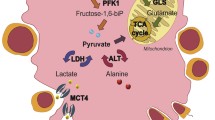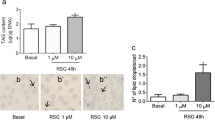Abstract
Sertoli cells (SCs) glucose metabolism is crucial for spermatogenesis since developing germ cells consume lactate produced by SCs as their main energy source. Recently, androgens and estrogens have been implicated in SCs energy metabolism modulation, although the molecular mechanisms remained undisclosed. Here, we report the effect of sex steroid hormones on key points of cultured rat SCs glycolytic pathway. We used primary cultures of immature rat SCs treated with 17β-estradiol (E2) or 5α-dihydrotestosterone (DHT). The transcript levels of glucose transporters (GLUTs), phosphofructokinase 1 (PFK-1) and lactate dehydrogenase C (LDH C) were analyzed after 25 and 50 h of culture by qPCR. Protein levels of GLUTs, PFK-1, LDH and monocarboxylate transporter 4 (MCT4) after 25 and 50 h were determined by western blot and LDH activity was also assessed. Our results show that both E2 and DHT downregulated the transcript levels of PFK-1, GLUT1 and GLUT3 after 50 h. However, only DHT-treated cells presented a downregulation of LDH C transcript levels. Interestingly, the protein levels of these enzymes and transporters remained unaltered except in DHT-treated cells that presented a significant decrease on GLUT1 protein levels evidencing a possible site for the regulation of SCs glucose metabolism by androgens. Taken together, our results provide evidence that sex steroid hormones action in SCs energy metabolism is mediated through modulation in glycolysis-related transporters and enzymes, particularly at the transcriptional level. DHT decreased GLUT1 protein levels and increased LDH activity after 25 h, evidencing key points for this hormone action in the regulation of SCs metabolism.





Similar content being viewed by others
References
Alves MG, Machado NG, Sardao VA, Carvalho RA, Oliveira PJ (2011) Anti-apoptotic protection afforded by cardioplegic celsior and histidine buffer solutions to hearts subjected to ischemia and ischemia/reperfusion. J Cell Biochem 112:3872–3881
Alves MG, Neuhaus-Oliveira A, Moreira PI, Socorro S, Oliveira PF (2013a) Exposure to 2,4-dichlorophenoxyacetic acid alters glucose metabolism in immature rat Sertoli cells. Reprod Toxicol 38C:81–88
Alves MG, Rato L, Carvalho RA, Moreira PI, Socorro S, Oliveira PF (2013b) Hormonal control of Sertoli cells metabolism regulates spermatogenesis. Cell Mol Life Sci 70:777–793
Alves MG, Socorro S, Silva J, Barros A, Sousa M, Cavaco JE, Oliveira PF (2012) In vitro cultured human Sertoli cells secrete high amounts of acetate that is stimulated by 17beta-estradiol and suppressed by insulin deprivation. Biochim Biophys Acta 1823:1389–1394
Boussouar F, Benahmed M (1999) Epidermal growth factor regulates glucose metabolism through lactate dehydrogenase A messenger ribonucleic acid expression in cultured porcine Sertoli cells. Biol Reprod 61:1139–1145
Boussouar F, Benahmed M (2004) Lactate and energy metabolism in male germ cells. Trends Endocrinol Metab 15:345–350
Chehtane M, Khaled AR (2010) Interleukin-7 mediates glucose utilization in lymphocytes through transcriptional regulation of the hexokinase II gene. Am J Physiol Cell Physiol 298:C1560–C1571
Galardo MN, Riera MF, Pellizzari EH, Chemes HE, Venara MC, Cigorraga SB, Meroni SB (2008) Regulation of expression of Sertoli cell glucose transporters 1 and 3 by FSH, IL1 beta, and bFGF at two different time-points in pubertal development. Cell Tissue Res 334:295–304
Granchi C, Bertini S, Macchia M, Minutolo F (2010) Inhibitors of lactate dehydrogenase isoforms and their therapeutic potentials. Curr Med Chem 17:672–697
Griswold MD (1998) The central role of Sertoli cells in spermatogenesis. Semin Cell Dev Biol 9:411–416
Gupta G, Srivastava A, Setty BS (1991) Androgen-estrogen synergy in the regulation of energy metabolism in epididymis and vas deferens of rhesus monkey. Endocr Res 17:383–394
Hawtrey C, Goldberg E (1968) Differential synthesis of LDH in mouse testes. Ann NY Acad Sci 151:611–615
Hess R, Carnes K (2004) The role of estrogen in testis and the male reproductive tract: a review and species comparison. Anim Reprod 1:5–30
Hollams EM, Giles KM, Thomson AM, Leedman PJ (2002) MRNA stability and the control of gene expression: implications for human disease. Neurochem Res 27:957–980
Johnson L, Thompson DL, Varner DD (2008) Role of Sertoli cell number and function on regulation of spermatogenesis. Anim Reprod Sci 105:23–51
Jutte NHPM, Jansen R, Grootegoed J, Rommerts F, Clausen O, Van der Molen H (1982) Regulation of survival of rat pachytene spermatocytes by lactate supply from Sertoli cells. J Reprod Fertil 65:431
Mahesh VB, Muldoon TG, Eldridge JC, Korach KS (1975) The role of steroid hormones in the regulation of gonadotropin secretion. J Steroid Biochem 6:1025–1036
Mahraoui L, Rodolosse A, Barbat A, Dussaulx E, Zweibaum A, Rousset M, Brot-Laroche E (1994) Presence and differential expression of SGLT1, GLUT1, GLUT2, GLUT3 and GLUT5 hexose-transporter mRNAs in Caco-2 cell clones in relation to cell growth and glucose consumption. Biochem J 298(Pt 3):629–633
Mor I, Cheung EC, Vousden KH (2011) Control of Glycolysis through Regulation of PFK1: Old Friends and Recent Additions. Cold Spring Harbor Symp Quant Biol 76:211–216
Oliveira PF, Alves MG, Rato L, Laurentino S, Silva J, Sa R, Barros A, Sousa M, Carvalho RA, Cavaco JE, Socorro S (2012) Effect of insulin deprivation on metabolism and metabolism-associated gene transcript levels of in vitro cultured human Sertoli cells. Biochim Biophys Acta 1820:84–89
Oliveira PF, Alves MG, Rato L, Silva J, Sa R, Barros A, Sousa M, Carvalho RA, Cavaco JE, Socorro S (2011) Influence of 5a-dihydrotestosterone and 17b-estradiol on human Sertoli cells metabolism. Int J Androl 34:e612–e620
Oliveira PF, Sousa M, Barros A, Moura T, Rebelo da Costa A (2009) Intracellular pH regulation in human Sertoli cells: role of membrane transporters. Reproduction 137:353–359
Orth JM, Gunsalus GL, Lamperti AA (1988) Evidence from Sertoli cell-depleted rats indicates that spermatid number in adults depends on numbers of Sertoli cells produced during perinatal development. Endocrinology 122:787–794
Rato L, Alves MG, Dias TR, Lopes G, Cavaco JE, Socorro S, Oliveira PF (2013) High-energy diets may induce a pre-diabetic state altering testicular glycolytic metabolic profile and male reproductive parameters. Andrology 1:495–504
Rato L, Alves MG, Socorro S, Carvalho RA, Cavaco JE, Oliveira PF (2012a) Metabolic modulation induced by oestradiol and DHT in immature rat Sertoli cells cultured in vitro. Biosci Rep 32:61–69
Rato L, Alves MG, Socorro S, Duarte AI, Cavaco JE, Oliveira PF (2012b) Metabolic regulation is important for spermatogenesis. Nat Rev Urol 9:330–338
Rato L, Socorro S, Cavaco JEB, Oliveira PF (2010) Tubular fluid secretion in the seminiferous epithelium: ion transporters and aquaporins in Sertoli cells. J Membr Biol 236:215–224
Riera MF, Galardo MN, Pellizzari EH, Meroni SB, Cigorraga SB (2009) Molecular mechanisms involved in Sertoli cell adaptation to glucose deprivation. Am J Physiol Endocrinol Metab 297:E907–E914
Robinson R, Fritz IB (1981) Metabolism of glucose by Sertoli cells in culture. Biol Reprod 24:1032–1041
Roth MY, Lin K, Amory J, Matsumoto A, Anawalt B, Snyder C, Kalhorn T, Bremner W, Page S (2010) Serum LH correlates highly with intratesticular steroid levels in normal men. J Androl 31:138
Setchell B, Laurie M, Flint A, Heap R (1983) Transport of free and conjugated steroids from the boar testis in lymph, venous blood and rete testis fluid. J Endocrinol 96:127–136
Setchell BP (2004) Hormones: what the testis really sees. Reprod Fertil Dev 16:535–545
Simões V, Alves M, Martins A, Dias T, Rato L, Socorro S, Oliveira P (2012) Regulation of Apoptotic Signaling Pathways by 5a-dihydrotestosterone and 17b-estradiol in Immature Rat Sertoli Cells. J Steroid Biochem Molec Biol 135C:15–23
Skidmore AF, Beebee TJC (1991) Changes in testicular lactate dehydrogenases of the rat (Rattus norvegicus) during growth and development. Comp Biochem Physiol 98:279–282
Smyth CM, Bremner WJ (1998) Klinefelter syndrome. Arch Intern Med 158:1309–1314
Steger K, Rey R, Kliesch S, Louis F, Schleicher G, Bergmann M (1996) Immunohistochemical detection of immature Sertoli cell markers in testicular tissue of infertile adult men: a preliminary study. Int J Androl 19:122–128
Strober W (2001) Trypan blue exclusion test of cell viability. Current protocols in immunology Appendix 3:Appendix 3B
Turner TT, Ewing LL, Jones CE, Howards SS, Zegeye B (1985) Androgens in male rat reproductive tract fluids: hypophysectomy and steroid replacement. Am J Physiol 248:E274–E280
Acknowledgments
Portuguese “Fundação para a Ciência e a Tecnologia” - FCT (PTDC/QUI-BIQ/121446/2010) co-funded by FEDER via Programa Operacional Factores de Competitividade - COMPETE/QREN. L. Rato (SFRH/BD/72733/2010) and M.G. Alves (SFRH/BPD/80451/2011) were financed by FCT. P.F. Oliveira was financed by FCT through FSE and POPH funds (Programa Ciência 2008).
Author information
Authors and Affiliations
Corresponding authors
Additional information
Ana D. Martins and Marco G. Alves contributed equally.
Rights and permissions
About this article
Cite this article
Martins, A.D., Alves, M.G., Simões, V.L. et al. Control of Sertoli cell metabolism by sex steroid hormones is mediated through modulation in glycolysis-related transporters and enzymes. Cell Tissue Res 354, 861–868 (2013). https://doi.org/10.1007/s00441-013-1722-7
Received:
Accepted:
Published:
Issue Date:
DOI: https://doi.org/10.1007/s00441-013-1722-7




